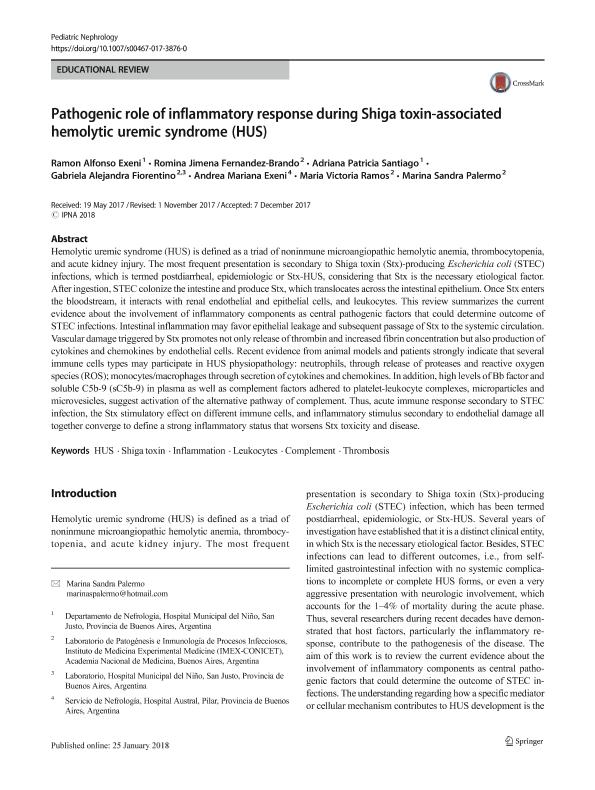Mostrar el registro sencillo del ítem
dc.contributor.author
Exeni, Ramon Alfonso
dc.contributor.author
Fernández Brando, Romina Jimena

dc.contributor.author
Santiago, Adriana Patricia
dc.contributor.author
Fiorentino, Gabriela Alejandra

dc.contributor.author
Exeni, Andrea Mariana
dc.contributor.author
Ramos, Maria Victoria

dc.contributor.author
Palermo, Marina Sandra

dc.date.available
2020-01-07T21:31:25Z
dc.date.issued
2018-11
dc.identifier.citation
Exeni, Ramon Alfonso; Fernández Brando, Romina Jimena; Santiago, Adriana Patricia; Fiorentino, Gabriela Alejandra; Exeni, Andrea Mariana; et al.; Pathogenic role of inflammatory response during Shiga toxin-associated hemolytic uremic syndrome (HUS); Springer; Pediatric Nephrology; 33; 11; 11-2018; 2057-2071
dc.identifier.issn
0931-041X
dc.identifier.uri
http://hdl.handle.net/11336/93929
dc.description.abstract
Hemolytic uremic syndrome (HUS) is defined as a triad of noninmune microangiopathic hemolytic anemia, thrombocytopenia, and acute kidney injury. The most frequent presentation is secondary to Shiga toxin (Stx)-producing Escherichia coli (STEC) infections, which is termed postdiarrheal, epidemiologic or Stx-HUS, considering that Stx is the necessary etiological factor. After ingestion, STEC colonize the intestine and produce Stx, which translocates across the intestinal epithelium. Once Stx enters the bloodstream, it interacts with renal endothelial and epithelial cells, and leukocytes. This review summarizes the current evidence about the involvement of inflammatory components as central pathogenic factors that could determine outcome of STEC infections. Intestinal inflammation may favor epithelial leakage and subsequent passage of Stx to the systemic circulation. Vascular damage triggered by Stx promotes not only release of thrombin and increased fibrin concentration but also production of cytokines and chemokines by endothelial cells. Recent evidence from animal models and patients strongly indicate that several immune cells types may participate in HUS physiopathology: neutrophils, through release of proteases and reactive oxygen species (ROS); monocytes/macrophages through secretion of cytokines and chemokines. In addition, high levels of Bb factor and soluble C5b-9 (sC5b-9) in plasma as well as complement factors adhered to platelet-leukocyte complexes, microparticles and microvesicles, suggest activation of the alternative pathway of complement. Thus, acute immune response secondary to STEC infection, the Stx stimulatory effect on different immune cells, and inflammatory stimulus secondary to endothelial damage all together converge to define a strong inflammatory status that worsens Stx toxicity and disease.
dc.format
application/pdf
dc.language.iso
eng
dc.publisher
Springer

dc.rights
info:eu-repo/semantics/openAccess
dc.rights.uri
https://creativecommons.org/licenses/by-nc-sa/2.5/ar/
dc.subject
COMPLEMENT
dc.subject
HUS
dc.subject
INFLAMMATION
dc.subject
LEUKOCYTES
dc.subject
SHIGA TOXIN
dc.subject
THROMBOSIS
dc.subject.classification
Inmunología

dc.subject.classification
Medicina Básica

dc.subject.classification
CIENCIAS MÉDICAS Y DE LA SALUD

dc.title
Pathogenic role of inflammatory response during Shiga toxin-associated hemolytic uremic syndrome (HUS)
dc.type
info:eu-repo/semantics/article
dc.type
info:ar-repo/semantics/artículo
dc.type
info:eu-repo/semantics/publishedVersion
dc.date.updated
2019-10-18T18:03:10Z
dc.journal.volume
33
dc.journal.number
11
dc.journal.pagination
2057-2071
dc.journal.pais
Alemania

dc.journal.ciudad
Berlín
dc.description.fil
Fil: Exeni, Ramon Alfonso. Provincia de Buenos Aires. Hospital Municipal del Niño; Argentina
dc.description.fil
Fil: Fernández Brando, Romina Jimena. Consejo Nacional de Investigaciones Científicas y Técnicas. Instituto de Medicina Experimental. Academia Nacional de Medicina de Buenos Aires. Instituto de Medicina Experimental; Argentina
dc.description.fil
Fil: Santiago, Adriana Patricia. Provincia de Buenos Aires. Hospital Municipal del Niño; Argentina
dc.description.fil
Fil: Fiorentino, Gabriela Alejandra. Consejo Nacional de Investigaciones Científicas y Técnicas. Instituto de Medicina Experimental. Academia Nacional de Medicina de Buenos Aires. Instituto de Medicina Experimental; Argentina. Provincia de Buenos Aires. Hospital Municipal del Niño; Argentina
dc.description.fil
Fil: Exeni, Andrea Mariana. Provincia de Buenos Aires. Hospital Austral; Argentina
dc.description.fil
Fil: Ramos, Maria Victoria. Consejo Nacional de Investigaciones Científicas y Técnicas. Instituto de Medicina Experimental. Academia Nacional de Medicina de Buenos Aires. Instituto de Medicina Experimental; Argentina
dc.description.fil
Fil: Palermo, Marina Sandra. Consejo Nacional de Investigaciones Científicas y Técnicas. Instituto de Medicina Experimental. Academia Nacional de Medicina de Buenos Aires. Instituto de Medicina Experimental; Argentina
dc.journal.title
Pediatric Nephrology

dc.relation.alternativeid
info:eu-repo/semantics/altIdentifier/url/http://link.springer.com/10.1007/s00467-017-3876-0
dc.relation.alternativeid
info:eu-repo/semantics/altIdentifier/doi/https://doi.org/10.1007/s00467-017-3876-0
Archivos asociados
